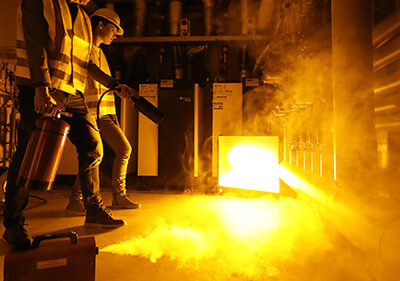Equipping employees with the right tools in times of fire hazards will help them handle these emergencies safer and more comfortably. As an employer, it is your responsibility to provide employees access to fire extinguishers and to train employees how to use them.
The 3 most common types of extinguishers that could be found in the workplace include:
- Water
- Carbon Dioxide / Halotron
- Dry Chemical
The different types of extinguishers are designed to work on different types of fires. Recalling the fire classifications that are explained in Part 1 of our Fire Extinguishers in the Workplace series, fires are classified as Class A, B, C or D, depending on what materials fuel the fire.
When to Use Which Extinguisher Type
Water Extinguisher: Designed to work on Class A fires only and should not be used on Class B, C or D fires. If you have no choice but to use a water extinguisher on an electrical fire, make sure the electrical equipment is unplugged or de-energized first to reduce the risk of electrocution. Water extinguishers are silver and about two feet tall.
Carbon Dioxide/Halotron Extinguisher: These red extinguishers should only be used on Class B or C fires. The pressure in these extinguishers is so great, dry ice may shoot out of the horn when extinguishing.
Dry Chemical Extinguisher: Also known as ABC fire extinguishers, these may be used on Class A, B and C fires. These red extinguishers are filled with fire retardant powder, which separates the fuel from the oxygen.
All fire extinguishers should be labeled to indicate the type of fire it can extinguish.
Extinguisher Installation and Placement
According to OSHA standards, employers must provide portable fire extinguishers for employee use based on the classes of anticipated workplace fires and on the size and degree of hazard which would affect their use.
Workspaces are classified as light, ordinary or extra hazard, and this classification determines the size of the fire extinguisher needed for that area and the maximum travel distance for that fire extinguisher. A light hazard area will not require the same size or number of extinguishers as an extra hazard area.
“When planning the placement of fire extinguishers in the workplace, it is important to remember that all extinguishers must be placed in the path of egress,” said Nick Daniels, Extinguisher Manager at Ryan Fireprotection. “Fire extinguishers must also be located no lower than four inches from the ground and no more than five feet from the top of the extinguisher to the floor.”
Stay tuned for Part 3 of our Fire Extinguishers in the workplace series, when we will discuss how to use a fire extinguisher and risk management in a fire. For a refresher, read Part 1 of Fire Extinguishers in the Workplace: Sources and Classes of Fire.
To have a Ryan Fireprotection professional perform a fire extinguisher training session, fill out this form or call 1.800.409.7606, and press 1 to be connected to our service department.

